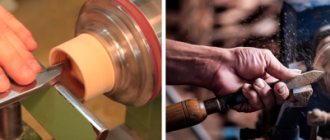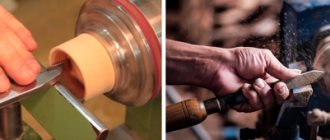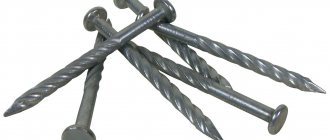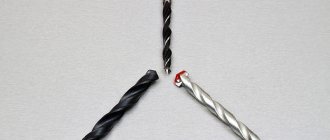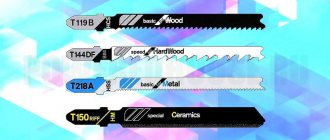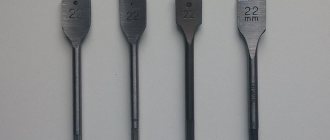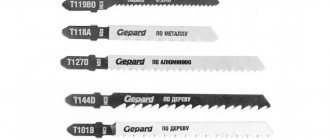Shank type
The shape of the part of the file inserted into the jigsaw - the shank - determines the way it is clamped in the tool.
Saws with a T-shaped tail are ubiquitous. They are suitable for most modern models of jigsaws for wood, such as those developed by BOSCH, a trendsetter in this area. In jargon they are called "European type".
American models (DeWalt, Black&Decker) use saws whose tail end ends in a semicircular cutout resembling the letter U. Such shanks fit all clamps with a block or screw. In the jargon - “American type”.
There are still special Makita shanks and T-shaped “Bosh” shanks, but with two stops. They are suitable only for old models of jigsaws from these companies and, rather, are rarities.
General provisions
Straight cutting on wood with a jigsaw
A file for a manual jigsaw for wood is a cutting tool that, during operation, makes translational movements up and down, making straight or figured cuts.
Tip: When purchasing an electric jigsaw, check for the pendulum function. Thanks to it, additional movement of the blade forward and backward occurs, which speeds up the process and reduces the load on the engine.
The use of such equipment greatly simplifies the processing of wooden and other products with your own hands. In addition, it makes it easy to create shaped cuts necessary when assembling certain structures or for the purpose of decorating them.
Tooth shape
The width and cleanliness of the cut, as well as the suitability of the saw for cutting specific materials, depend on the method of sharpening and setting the teeth of a jigsaw on wood. There are 4 categories.
The first category includes milled files with a regular set. The classic set-up involves alternating bending of the teeth in different directions. A regular saw or hacksaw has such a problem. It produces a wide kerf and high cutting speed, but does not provide cleanliness. The best results are obtained when quickly cutting any type of wood, plastic and even metal.
The second category is milled with a “wave” type pattern. The teeth are not set one by one, but in groups of several pieces. The amount of spread is different for each tooth in the group, so the cutting edge looks like a wave. This file provides good cutting quality and is used for different materials when it is necessary to obtain an even and smooth cut without chips.
Next come files with ground teeth and a classic alternating set. They are characterized by high cutting speed and a wide kerf, the cleanliness of which is better than that of the milled version. Their purpose is fast but high-quality cutting of wood and wood-based materials (chipboard, fiberboard).
Finally comes the category of jigsaw files for wood without cutting with conical grinding of the teeth. The absence of a mark gives a clean and thin cut, but is not suitable for fast and rough cutting. Used for finishing wood and polymers.
Classification and features according to the type of material being processed
The modern market offers a large selection of different saws for sawing the same material. They differ in length, shape and size of the tooth, pitch and metal from which they are made. But they belong to the same group, for example, a type of wood saw.
We also recommend reading an interesting article on how to choose a jigsaw; it contains 9 best tips from an expert that will help you make the right choice.
Tree
For this material, you can choose a file with a length from 75 mm to 150 mm.
As a rule, they are all labeled with the word Wood (wood) or Hardwood (hard, hard wood). Different types of files are selected for different tasks.
- A saw with large, sparse teeth, up to 6 mm, will provide a quick rough cut.
- A cleaner cut is made with saws with teeth of about 3 mm.
- For curly cutting along curved lines, a narrow file with a fine tooth, about 2 mm, is suitable.
Laminate
For sawing various laminates, saw blades are selected according to the same principle as for wood. The only difference is that the file must have a medium or fine tooth, designed for laminate, or be universal (wood/plastic).
Metal
An electric jigsaw is rarely used for cutting metal. There are cutting methods that are much more efficient (angle grinders with cutting wheels for metal, hand jigsaws with long files, gas cutters, etc.). However, in some cases it is rational to use a jigsaw with a suitable file.
For example, a long cut with a complex curvilinear shape (rounds and circles, sharp triangles, etc.) cannot be made with a cutting wheel and a hand jigsaw. It is not recommended to use a jigsaw to cut metal thicker than 3 mm, especially black.
Metal files are marked Alu for soft metals or Metal for ferrous metals, galvanized and stainless steel.
Steel grade – high-speed cutter HSS or bimetal BiM.
Plastic
The plastic is sawed off by turning off the pendulum stroke. Files with small and medium teeth of short length are used. Fiber&Plaster marking. For certain types of plastic (PVC), files for hard wood (Hardwood), or universal ones with the inscription “wood/plastic” in Russian or English, are sometimes well suited.
Glass
It is impossible to cut ordinary glass with saws. For this, glass cutters with a diamond wheel are used. You can use saws to cut plexiglass, which is a transparent type of plastic. They also cut it with the same files as plastics (see above).
Ceramics
Ceramics are hard and brittle materials. To cut it, special saw blades with a carbide coating are used, which is much stronger than ceramics. Most often it is tungsten carbide or artificial diamond powder. The file itself is made of ordinary tool steel. The marking of such files is Carbide Technology (CT) or NM. The blade is smooth, without teeth.
Soft materials (rubber)
Universal and special files are suitable for such materials. The first ones should be tried in practice during practical cutting. Rubber, paper and other materials are cut completely differently. Special files are made specifically for a specific material. They can have teeth or be wavy (for cardboard, foam, rubber, etc.). Suitable files may be labeled SoftMaterial or Acrylic.
Universal
There are no absolutely universal files “for all materials”. But often the same files can be used to cut different materials with different densities, structures, viscosities and strengths.
For example, a metal saw can cut wood and plastic. In this case, the file may get stuck in rubber or linoleum due to strong friction and sawdust sticking in the slot . Therefore, the selection of saw blades, even if they are positioned by sellers and manufacturers as universal, is only possible with trial cuts.
Files are often sold in a set that includes files for a variety of materials. This is convenient for users.
- Firstly , there is no need to look separately for special files for different materials.
- Secondly , it is possible to try how the saws will cut different materials. For example, a saw for metal – wood.
Canvas dimensions
The capabilities of jigsaw blades are determined not only by the size and shape of the cutting edge. The geometric characteristics of the canvas itself also affect the speed and quality of work. Plus, its dimensions must be selected based on the type and dimensions of the material being processed.
Length
The lengths of jigsaw blades are in the range of 40–250 mm. When choosing a specific length of a jigsaw file, you need to take into account the thickness of the material in the work. It is clear that to cut thick wooden workpieces you need a long saw blade for a wood jigsaw. But if you cut thin sheet materials with a long blade, then due to the possible bending of the metal, it is difficult to obtain an even cut.
Note! When working with long blades, you should understand that the working depth of the cut is affected by the power of the jigsaw.
Width
You need to select the width of the saw blade based on the type of work to be done. For simple sawing, where a straight and even edge is required, wide files are taken. A narrow blade may move during operation, and a straight cutting line will not work.
But when cutting out shapes of varying degrees of complexity, you need to choose narrow jigsaw blades. It is easier to direct them to the side, drawing curved lines.
Thickness
For sawing thin sheet materials, the thickness of the file does not matter much. But when working with thick workpieces, this size affects the quality of the sawn surface. Thin blades will deviate from the perpendicular line during operation, and the cut will be uneven. The thicker the blade, the more even the cut it provides. But there is one caveat - too thick a blade is not suitable for all models of jigsaws. Jigsaws equipped with quick-release devices may not be suitable for thick blades.
Examples
To consolidate the information received, let's look at a couple of the most common options:
- T101D is an inexpensive short model designed for sawing boards, chipboard and thick plywood. It has a large tooth, good speed and acceptable cut quality.
The most common file in sets
- T101B – the presence of a small tooth allows for a more even cut, due to which, however, the speed of the process decreases. Suitable for plywood, chipboard, fibreboard, plexiglass and plastic.
Fine tooth – smooth cut
What do the markings on files mean?
Even knowing all the intricacies of choosing a suitable jigsaw file and having determined the required parameter values for yourself, you can get confused among the many products offered. Don’t go to the store with a ruler and calipers, measuring the dimensions of each blade and the pitch of the teeth!
Files from well-known manufacturers are necessarily marked with various markings that provide approximate information about the parameters of this product. Of course, if you want to know the exact values, you can measure them with a ruler. But it is better to do this not with every canvas, but only with one - pre-selected by marking.
There is no mandatory labeling standard. Most manufacturers of jigsaw files adhere to the rules adopted by BOSCH. It is rare, but you can find markings that differ from these rules.
According to BOSCH standards, alphanumeric markings are applied to the shank of the jigsaw file. The first letter of the marking indicates the type of shank: T-shaped or U-shaped.
The number following the letter refers to the length of the canvas. But this is not the length itself, but the number of the corresponding length range.
1 – short files with a length of up to 75 mm;
2 – average length: 75–90 mm;
3 – long: 90–150 mm;
4 – very long, more than 150 mm.
The next two numbers encrypt the purpose of the file (according to the manufacturers). The same information is usually present in other places on the saw blade in a form that is more understandable to the consumer.
The first letter following the numbers indicates the tooth size:
- A – small;
- B – average;
- C and D – big.
The second letter (if there is one) gives additional information about files that are somewhat different from ordinary ones.
F – especially durable material, bimetal.
O - small width, for figured cutting.
P – large thickness.
R – reverse direction of teeth.
X – teeth of variable size.
Important information about the purpose is duplicated by the markings twice: by the color of the shank and the words on the canvas itself.
For wood – gray; the words Wood (plain wood) and HardWood (hard wood and laminate).
For metal – blue color; the words Metal (metal), Alu (aluminum), Inox (stainless steel). Universal tool for wood and metal – white.
For polymeric materials – red color; the words Acrylic and Fiber&Plaster (fiberglass).
For other materials – black; for example Soft-material (soft materials - rubber, foam).
For ceramics – Ceramics.
Elsewhere on the canvas there may be verbal information about the method of application and special properties (usually in smaller letters than about the material of use):
- basic – standard type of canvas;
- speed – for fast cutting;
- flexible – with a “wave” type connection;
- clean - without streaks, clean cut;
- progressor – variable tooth size;
- special – for highly specialized applications (ceramics, durable plastic, etc.)
A letter marking of the type of metal from which it is made is applied to the neck of the file (between the shank and the blade itself):
- HM – hard alloy;
- CV – chrome vanadium alloy;
- HSS – high-speed steel;
- HCS – high carbon steel;
- VM or ViM is a particularly strong alloy.
Thus, by studying the markings on a jigsaw file, you can obtain comprehensive information about it.
Top 5 Quality Universal Electric Jigsaw Kits
Recognized leaders in the production of saw blades have not changed since 2022. The high quality and product characteristics of popular models are checked daily on construction sites, furniture production and home repairs. The rating of universal configurations, based on customer opinions, will tell you which consumables are best to buy.
5th place. Stayer Station wagon 159488-Н5
Average price: 132 rubles.
The manufacturer produces a wide range of hand and power tools. In Russia since 1999. Many buyers recognize the quality and reliability of the product and vote for it with increasing demand.
Saw consumables are made from resistant carbon steel, which ensures flexibility and long service life; a special protective coating on the cutting edge allows you to maintain the sharpness of the blade.
Stayer Station wagon 159488-Н5
Advantages:
- main types of cutting: clean, fast, figured;
- processes chipboard, metal, wood, plywood, fiberboard;
- 5 pieces included;
- T-shank;
- budget brand.
Flaws:
- not found.
4th place. "DeWALT"DT 2294
Average price: 739 rubles.
The company's 90-year history is an example of the reliability of the designed equipment. Powerful, durable and precise power tools are complemented by high-performance accessories. Carbon and bimetallic types of steel are used for it. The recognizable yellow and black colors have become a symbol of Swiss quality.
"DeWALT"DT 2294
Advantages:
- for wood and metal blanks;
- 3 types of cuts: clean, fast, figured;
- universal tail section;
- 10 pieces included.
Flaws:
- high price;
- confusing markings.
3rd place. Set “Gross”78295
Average price: 738 rubles.
German quality has been repeatedly confirmed by numerous customers. The company produces tools for professional processing of all types of wood, fiberboard, chipboard, PVC up to 60 mm, laminate boards and high-quality blades for it. Durable steel cutting surfaces made of chrome and vanadium have a long service life. Wear-resistant, with increased hardness.
"Gross"78295
Advantages:
- perform basic types of cuts: rough, fast, clean;
- for metal and wooden surfaces;
- T-shaped European shank;
- 10 pieces per pack.
Flaws:
- high price.
2nd place. Set “Bosch” Mixed Wood and Metall 2609256746
Average price: 599 rubles.
occupies a strong place among the leaders in manufacturers of consumables for power tools. The widest range allows you to select both a single item and a specific set. Modern alloys extend the service life of the product.
The company has introduced its own labeling, which is also used by other manufacturers. Components are produced in Switzerland or the UK, the T-shank is compatible with power tools from Makita, Hitachi, AEG, Metabo, etc.
Set “Bosch” Mixed Wood and Metall 2609256746
Advantages:
- various files for metal, aluminum, several types of wood;
- information packaging;
- 10 pieces per set, 2 of each type;
- universal shank;
- average price category.
Flaws:
- one type of cut is fast.
1 place. Set “Makita” А-86899
Average price: 350 rubles.
A Japanese brand that produces power tools and high-quality equipment for work in professional fields and private use. Durable steel compounds make the files resistant to mechanical wear, bending and creases.
Set “Makita” А-86899
Advantages:
- for wood, metal, plastic;
- T-shank;
- type of cut: rough, clean, fast;
- 5 pieces per pack.
Flaws:
- unclear markings;
- high price.
Types of files according to purpose
The word jigsaw still evokes associations with wood. And although modern jigsaws are widely used for sawing plastics and metals, the main material for work is still wood and plywood. You also have to think most often about which blades to choose for a jigsaw on wood.
On wood
For general work on wood and its derivatives (plywood, chipboard, MDF), standard saw blades with a gray shank for simple or hard wood are chosen. The dimensions of the blade, the spread and the size of the teeth are selected individually. But sometimes it is necessary to perform work that differs from ordinary sawing.
If speed is important, even at the expense of the quality of the cut, then you need to choose long saws with large teeth and a large pitch. Divorce is also desirable more.
If you need to get an even and smooth cut without chips, then take blades with a small mark or without it at all. Teeth – medium or fine. Materials that have a finishing side (laminate, chipboard) have to be cut upside down. If you want to see the cut from the front side, then you need to choose files with the teeth in the opposite direction (the last letter of the marking is R).
For artistic cutting there should be a narrow blade no wider than 4 mm, small teeth and short length. Compliance with these conditions will allow figure cutting to be carried out at small turning radii.
For metal
An electric jigsaw is still not the most suitable tool for cutting metal. But if necessary, he can handle it if you choose the right file. The teeth of such files are very small and wavy; the blades are made of especially strong alloys, but they also quickly become dull. It is advisable to select files marked specifically for the type of metal you will be working with.
For polymer materials
The file markings contain designations specifically for working with such materials. Ordinary plastic and PVC products can also be sawed with wood blades. In this case, the teeth must be chosen larger and with a larger spread. A small tooth will not only cut, but also melt the material. For plexiglass, it is better to choose a metal fabric with a wavy pattern.
For special materials
These options have their own designation. First of all, it is ceramics. The files for it are made of special alloys, and the teeth are made with a special durable coating.
Also, especially strong coated teeth are required for cutting drywall.
But for soft materials, files without teeth are produced at all. Their cutting edge is a smooth blade, sharpened in a wave-like manner.
Voting for the best set of jigsaw files
What set of jigsaw files would you choose or recommend?
BOSCH 2607011437
29.07 % ( 25 )
BOSCH 2607011170
22.09 % ( 19 )
DeWALT DT 2294
10.47 % ( 9 )
Makita A-86898
18.60 % ( 16 )
DeWALT DT 2296
6.98 % ( 6 )
Hammerflex JG WD-PL 204-903
3.49 % ( 3 )
Diold T101V
4.65 % ( 4 )
RUNEX HSS T118B
0.00 % ( 0 )
HYUNDAI T119B 204107
0.00 % ( 0 )
